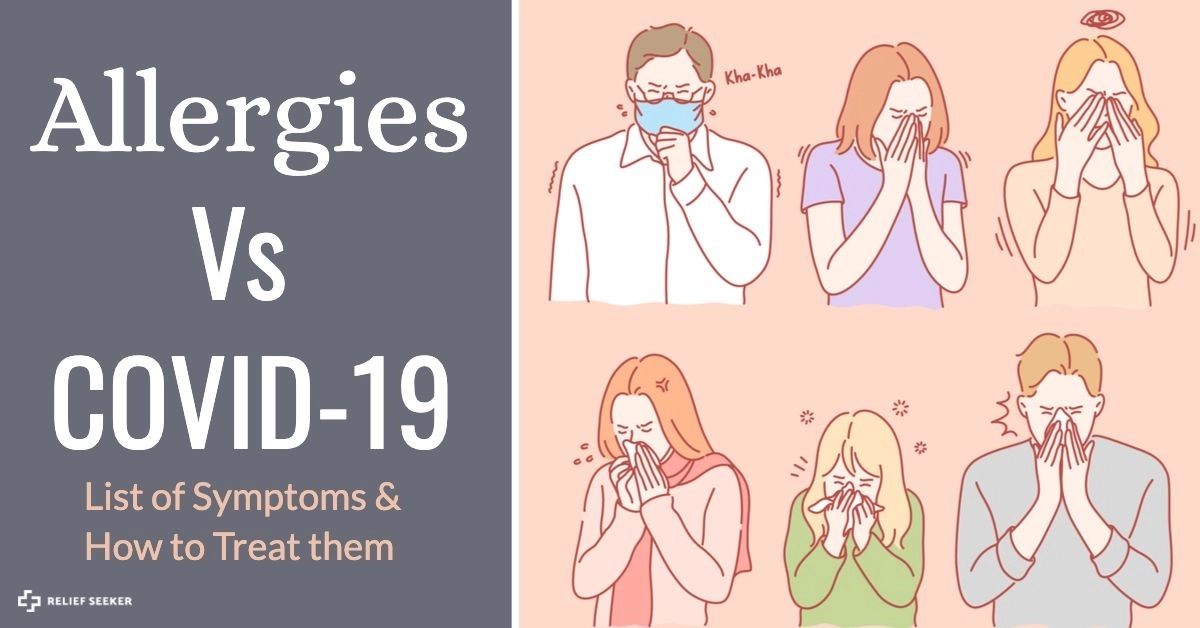To add to the fear of living through the COVID-19 pandemic, a few conditions share symptoms with the novel coronavirus, including the cold and flu viruses and allergies.
With seasonal allergies starting in early spring and often lasting through late autumn in most areas of the U.S., allergy symptoms can take over our lives for up to nine months of the year. If we can’t differentiate between allergy and COVID symptoms, we start putting our loved ones at risk of exposure.
Discover the difference between allergy symptoms versus COVID-19 symptoms, what to do if you’re struggling with allergies, and how to get tested for COVID.
What Are Allergies?
Allergies are an immune system response to outside stimuli (allergens). Though allergens are essentially harmless, the body sees them as a threat and releases antibodies to attack them. This response also leads to swelling, inflammation, redness, itching, congestion, and more.
Common Allergy Symptoms
The most common allergy symptoms include:
Chest tightness
Congestion
Hives
Itchy eyes and nose
Red rash
Runny nose
Shortness of breath
Sinus pressure/pain
Sneezing
Stomach pain
Swelling
Vomiting
Watering eyes and nose
Wheezing
Not only do allergies and COVID share symptoms, but both also share symptoms with common flu and cold symptoms, too. This simply means you need to be extra careful when exhibiting these symptoms, as you don’t want to spread the cold, flu, or coronavirus to anyone else.
What Is COVID-19?
COVID-19 is a novel coronavirus, discovered in 2019. It reached a pandemic level in early 2020.
Common COVID-19 Symptoms
Symptoms may appear 2-14 days after exposure to the virus. People with these symptoms may have COVID-19:
The most common symptoms of COVID-19 may include:
Aches and pains
Chills
Congestion
Dry cough
Fatigue
Fever
Loss of smell
Loss of taste
Nausea
Runny nose
Shortness of breath
Sore throat
Vomiting
Common emergency signs of COVID-19 may include the following:
Shortness of breath
Difficulty breathing
Chest pain and pressure
Confusion
Inability to remain conscious
Blue, gray, or pale skin, lips, or fingers
If you are suffering from any of the emergency symptoms of COVID-19, call 911 or head to the nearest emergency room.
Allergy Symptoms Vs COVID-19
Both COVID-19 and allergies share similar symptoms, so it’s hard to know if you’re suffering from allergies, a cold or flu virus, or the novel coronavirus.
The main differences between COVID and allergy symptoms are the severity of symptoms and a few symptoms that differ between the novel coronavirus and allergies.
If you’re suffering from a loss of taste or smell (that isn’t caused by congestion), you probably have contracted COVID. If you suspect you have COVID, you should make an appointment for testing. If you’re too sick to leave home (or have received a positive COVID test result), you should quarantine immediately to ensure you don’t infect anyone else.
How Long Should Symptoms Last?
Allergy symptoms generally last between a few weeks and a few months, and COVID symptoms last up to a few weeks (though the length of time in which symptoms are present will differ for each individual).
How Long Do Allergy Symptoms Last?
Allergy symptoms may last as long as you are exposed to the allergen.
For seasonal allergies, your symptoms should last as long as the allergy season (or as long as it takes to treat your allergic reaction). The most common seasonal allergens include pollen and weeds.
Most people notice their symptoms start to dissipate after pollen levels return to normal; though some people suffer from seasonal allergies from spring through autumn.
Environmental allergens can pop up any time or place and will last as long as you are in contact with those allergens. The most common environmental allergens include animals (including pet dander), dust, mold, and bugs (especially dust mites and cockroaches).
How Long Do COVID Symptoms Last?
Most COVID symptoms (especially the symptoms the virus shares with allergies, including coughing, sneezing, and congestion) will last up to a few weeks. Symptoms generally arise within 2-to-14 days of contracting the virus and may last up to two weeks after they first appear.
Other COVID symptoms may last longer, including loss of smell or taste.
Some patients may experience lingering COVID-19 symptoms that last for several months. The Centers for Disease Control and Prevention (CDC) is currently researching the long-term effects of the virus, but we may not definitively understand these effects for several months to several years.
Allergy & COVID Vs Cold and Flu Symptoms
To throw another wrench in the health cog, allergies and COVID also share symptoms with the cold and flu viruses.
Like with COVID, most cold and flu patients experience symptoms only for several days to a few weeks. Most symptoms simply subside after treatment and recovery.
If you’re sick, you may want to get tested for COVID-19 just to rule out this virus; you can also get tested for the flu at many urgent care centers and general care practitioners’ offices. At-home urgent care providers may also provide testing for the flu virus.
While cold and flu viruses don’t cause serious issues for most patients, those with underlying conditions may want to monitor their symptoms closely with their doctor to ensure these viruses don’t lead to more serious conditions.
Diagnosing Allergies
If you’re concerned that your symptoms are caused by the novel coronavirus, you should get tested for COVID and quarantine until you get a negative test result. Yet if your symptoms are most likely caused by seasonal allergies, diagnosis is relatively easy.
The two most common ways to diagnose seasonal allergies are at an allergist’s or doctor’s office or through an at-home testing kit provider.
In-Person Allergy Testing
Both doctors and allergists offer allergy testing. These tests are relatively straightforward; head to a lab for a blood draw or visit your allergy for a skin scratch test.
Blood draws simply test your blood for possible allergies. If you opt for a skin scratch test, your doctor will scratch or prick the surface of your skin with needles that contain small amounts of different allergens. If your skin reacts to a substance, you’re probably allergic to it.
Doctors can test for up to 50 allergens at once.
The only downside to visiting a doctor for this test is that you’ll need to head to an office or lab for testing. Most allergists charge around $5 per test ($250 for 50 allergens).
At-Home Allergy Testing
At-home testing kit companies like EverlyWell also provide allergy tests. Yet you can perform these tests yourself in the comfort of your own home.
Simply fill out a questionnaire and order your testing kit online. Get your kit in the mail, and follow the instructions to take your sample (usually a finger prick to collect a blood sample). Mail your sample to the lab, and get your results within a few days.
Diagnosing COVID
Diagnosing COVID-19 can be a little tricky since many symptoms of this virus are also symptoms of other common conditions. Most doctors will ask you to list your symptoms, recall if you’ve been exposed to someone suffering from the virus, and recommend getting tested.
Check Symptoms
You’ll want to start by checking your symptoms. If you are suffering from common COVID-19 symptoms, you may have contracted the virus (though you may also be suffering from cold, flu, or allergy symptoms, too).
If you’re suffering from serious symptoms, such as shortness of breath, unable to remain conscious, or blue-colored skin, you’ll want to call 911 or head to the closest emergency room for treatment.
Contact History
Most doctors will ask you about your contact history when diagnosing COVID-19. If you’re showing symptoms of the virus and have been exposed to someone that has contracted the virus, you have a higher risk of testing positive for COVID.
Even if you haven’t been exposed to someone with the virus (or if you have been exposed but aren’t showing any symptoms), your doctor may still recommend getting tested for COVID-19.
Get Tested
If you think you may have contracted COVID, it’s important to get tested. COVID-19 testing is free for all U.S. citizens right now through pharmacies and select testing sites and urgent care centers. Check with your local testing site before making an appointment to find out if testing is offered free of charge without health insurance.
Testing Sites/Pharmacies
States and cities across the U.S. have opened COVID-19 testing sites. The COVID test is also available at select pharmacies (such as Walgreens and CVS) across the country.
Schedule an appointment online and follow the instructions when your test is provided. Many testing sites offer self-testing (PCR and rapid testing) while other sites’ staff will perform the nasal swab test for you.
Results are available usually within three to five business days. PCR tests provide reliable results in less time (and produce very few false negatives). Rapid test results are available within 30 minutes, but the test may provide a false negative result.
Urgent Care
Most urgent care facilities across the country are now also offering COVID-19 testing. These facilities often bill insurance but may not provide free testing through government programs. Call in advance to find out if your local urgent care center charges for testing.
Urgent care facilities usually offer walk-in services for urgent care needs. Many of these sites don’t require an appointment; simply head in and wait for the doctor.
It’s still best to call ahead and find out if you need an appointment for COVID testing, as many urgent care centers don’t allow walk-ins for this type of care.
At-Home Urgent Care
At-home urgent care providers like Ready provide same-day COVID tests for patients that cannot (or simply don’t want to) leave their homes to get tested — whether it’s for medical, personal, or mobility reasons.
Simply call Ready’s dispatcher and explain you need a COVID test. You’ll be asked a series of questions about your symptoms and history. A certified EMT or PA Ready responder will arrive at your home (usually within a few hours) and perform the test.
Results are available within a few days.
You’ll need to quarantine while waiting for your test results so you don’t accidentally infect someone else with the novel coronavirus.
Allergies Treatment
If it turns out you’re suffering from allergy symptoms, the good news is that they’re treatable! There are several allergy treatments currently available; some treat the symptoms of allergies while others address the allergies themselves.
Prescription Allergy Medication
One of the most convenient allergy treatments is a personalized prescription medication.
Medication is usually available in oral antihistamines, nasal spray, or eye drop form. You can head to an allergist’s or doctor’s office for a prescription, or you can get allergy treatment from telehealth allergy medication providers such as Picnic.
Simply fill out a form, explain your symptoms, and submit your medical history information online. An allergist or doctor will provide an online consultation and prescribe generic allergy medication that will be delivered right to your door.
OTC Medication
Similar to prescription medication, OTC medications provide on-the-spot allergy relief. Most prescription allergy medications are available over the counter — but contain the median amount of active ingredients for most patients (not for each individualized patient).
The biggest downside to OTC medication is that you’ll end up with the same exact dose as everyone else. You may also end up paying more for prescriptions at drugstores or big-box retailers that don’t accept health insurance or don’t offer generic forms of medication.
You can generally find OTC allergy meds online and at local pharmacies, drugstores, department stores — and generally wherever medication is sold.
Allergy Immunotherapy
Allergy immunotherapy is a popular way to treat the source of allergies, not just the symptoms.
Allergic reactions are caused by the immune system’s response to unharmful stimuli, and introducing small amounts of the allergen could help your body build immunity. After exposing your body to the allergen over a period of months to years, your body will build a resistance to it and stop releasing antibodies to attack it.
Allergy immunotherapy is available through allergy shots, oral therapy, and toothpaste form. The biggest downside to these treatments is that they generally cost between $1,000 and $5,000 for the full treatment.
COVID Treatment
The treatment for many COVID-19 cases is similar to treatments for the flu or cold viruses. Most patients will need to rest for one-to-two weeks and force fluids. Some patients suffering from shortness of breath are given inhalers.
For serious COVID-19 cases, you may need to visit a doctor or hospital for treatment. Before heading to a doctor’s office or urgent care center, you’ll want to call ahead and make an appointment (you shouldn’t expose yourself to others before calling ahead to make sure your doctor is treating COVID).
If you’re experiencing emergency symptoms, such as shortness of breath or loss of consciousness, you should call 911 or head to the nearest emergency room for treatment.


